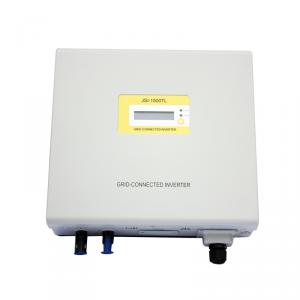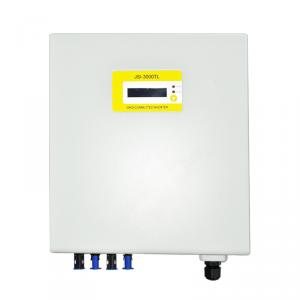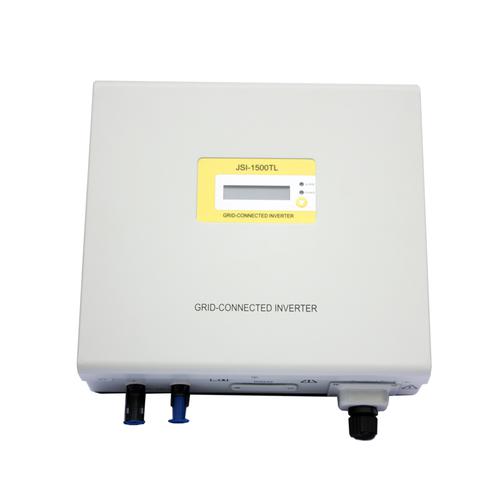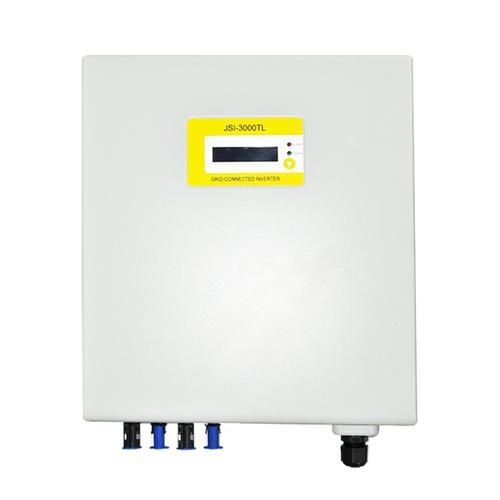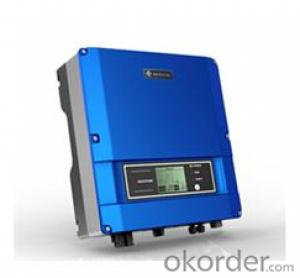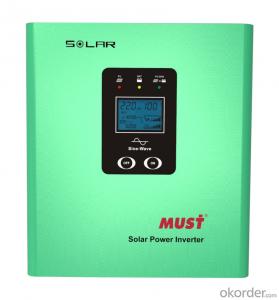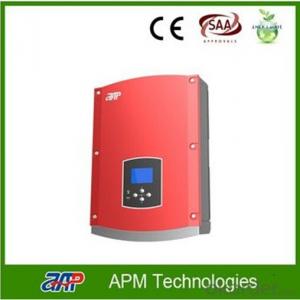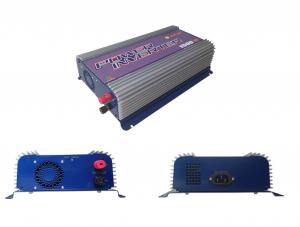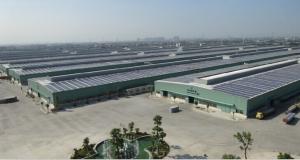25 Kw Grid Tied Solar Inverter Single Phase 1500W
OKorder Service Pledge
Quality Product, Order Online Tracking, Timely Delivery
OKorder Financial Service
Credit Rating, Credit Services, Credit Purchasing
You Might Also Like
Grid tied solar inverter Single phase 1500W
◆ Compact size and high power density
◆ High speed MPPT for real time power tracking and improved energy harvesting
◆ Transformerless operation for highest efficiency 97%
◆ High overload capability under most ambient conditions
◆ Certified grid connected operation according to the international standards
◆ True sine wave output
◆ Integrated RS485/RS232 serial communications
◆ Multi-language LCD display
| MODEL | 1100TL | 1500TL | 2000TL | 2500TL | 3000TL | 3600TL | 5000TL | 6000TL |
| Max. DC Input Power(W) | 1200 | 1750 | 2300 | 2700 | 3660 | 3750 | 5300 | 6400 |
| Max DC Voltage(Vdc) | 450 | 450 | 500 | 550 | ||||
| MPPT Operating Range(Vdc) | 60~450 | 100~450 | 100~500 | |||||
| Number of Parallel Inputs | 1 | 2 | 3 | |||||
| Number of MPPT Trackers | 1 | |||||||
| Max. Input Current(A) | 11.7 | 10 | 13 | 14.5 | 20 | 20 | 22.5 | 27.5 |
| Nominal Output Power(W) | 1100 | 1500 | 2000 | 2490 | 3000 | 3600 | 4600 | 6000 |
| Max. Output Power(W) | 1100 | 1650 | 2200 | 2490 | 3400 | 3600 | 5000 | 6000 |
| Nominal Output Current(A) | 4.8 | 6.5 | 8.7 | 10.8 | 13 | 15.7 | 20 | 26 |
| Max. Output Current(A) | 5.7 | 7.9 | 10.5 | 12 | 15.7 | 16 | 24 | 29.3 |
| Nominal AC Output Voltage(Vac) | 230 | |||||||
| AC Output voltage range (Vac)* | 190~265 | |||||||
| AC Grid frequency range (Hz)* | 50±5 | |||||||
| Power Factor (cosφ) | >0.99 | |||||||
| THDI | <3%(at nominal output power) | |||||||
| Max.efficiency | 96.50% | 96.50% | 97.00% | 97.10% | 97.20% | 97.30% | 97.40% | 97.40% |
| Euro.efficiency | 95.40% | 95.50% | 96.20% | 96.30% | 96.40% | 96.60% | 96.80% | 96.80% |
| MPPT. efficiency | 99.60% | 99.60% | 99.60% | 99.60% | 99.60% | 99.60% | 99.60% | 99.60% |
| Operating Temperature(℃) | -25~+60 | |||||||
| Noise typical[dB(A)] | ≤20dB(A) | |||||||
| Operating Consumption(W) | 0 | |||||||
| Electrical Isolation | Transformerless | |||||||
| Cooling Concept | Natural cooling | |||||||
| Protect Level | IP65 | |||||||
| Communication | RS232(WiFi optional) | |||||||
| Dimension (W×D×H)(mm) | 345*152*315 | 345*152*355 | 345*152*385 | 345*152*505 | 345*162*573 | |||
| Weight (Kg) | 12 | 13 | 15 | 19 | 24 | |||
| *AC grid voltage range and frequency range depend on local standards | ||||||||
- Q: Can a solar inverter be used with different types of backup power configurations?
- Yes, a solar inverter can be used with different types of backup power configurations. Solar inverters are designed to convert the DC power generated by solar panels into AC power that can be used to power electrical devices and appliances. They can be integrated with various backup power systems such as batteries, generators, or grid connections to provide uninterrupted power supply during periods of low solar generation or power outages. The versatility of solar inverters allows for flexibility in choosing and combining backup power sources based on specific needs and preferences.
- Q: How does the input current rating affect the performance of a solar inverter?
- The input current rating of a solar inverter affects its performance by determining the maximum amount of current it can handle from the solar panels. If the input current rating is too low, it may limit the amount of power that can be converted and fed into the electrical system. On the other hand, if the input current rating is too high, it may lead to excessive heat generation and potential damage to the inverter. Therefore, selecting an appropriate input current rating is crucial for optimal performance and efficient energy conversion of a solar inverter.
- Q: What is the role of a solar inverter in a solar-powered ventilation system?
- The role of a solar inverter in a solar-powered ventilation system is to convert the direct current (DC) generated by solar panels into alternating current (AC) that can be used to power the ventilation system. It ensures that the electricity generated by the solar panels is compatible with the system's requirements and can efficiently operate the ventilation components.
- Q: Can a solar inverter be used in harsh environmental conditions?
- Yes, a solar inverter can be used in harsh environmental conditions. Most solar inverters are designed to withstand a wide range of environmental factors such as extreme temperatures, humidity, dust, and vibrations. They are often built with durable materials and have protective coatings to prevent damage from harsh weather conditions. Additionally, many solar inverters are equipped with advanced cooling mechanisms to prevent overheating in hot climates. However, it is important to note that the specific durability and performance of a solar inverter in harsh conditions may vary depending on the brand and model. It is recommended to choose a reliable and high-quality solar inverter that is specifically designed for use in harsh environmental conditions to ensure optimal performance and longevity.
- Q: Can a solar inverter be used with solar-powered desalination systems?
- Yes, a solar inverter can be used with solar-powered desalination systems. A solar inverter is essential in converting the direct current (DC) power generated by solar panels into alternating current (AC) power that can be used to operate the desalination system. This allows for the efficient utilization of solar energy for powering the desalination process.
- Q: Can a solar inverter be used in areas with high dust and dirt accumulation?
- Yes, a solar inverter can be used in areas with high dust and dirt accumulation. However, it is important to regularly clean and maintain the inverter to prevent any performance issues caused by the accumulation of dust and dirt.
- Q: How does a solar inverter handle frequency variations in the grid?
- A solar inverter handles frequency variations in the grid by continuously monitoring the frequency and adjusting its own output accordingly. If the grid frequency increases, the inverter reduces its output to prevent overloading. Conversely, if the frequency decreases, the inverter increases its output to maintain a stable supply. This dynamic response ensures that the solar inverter efficiently synchronizes with the grid and contributes to grid stability.
- Q: Can a solar inverter be used in off-grid systems?
- Yes, a solar inverter can be used in off-grid systems. In off-grid systems, solar inverters are essential as they convert the direct current (DC) generated by the solar panels into alternating current (AC) that can be used to power appliances and devices. They also play a crucial role in managing the battery storage and regulating energy flow in off-grid setups.
- Q: Can a solar inverter be used with a solar-powered heating system?
- Yes, a solar inverter can be used with a solar-powered heating system. The solar inverter converts the direct current (DC) generated by the solar panels into alternating current (AC) which can be used to power various appliances, including a heating system. This allows the solar panels to provide clean and renewable energy for heating purposes.
- Q: How does a solar inverter affect the value of a property?
- A solar inverter can positively impact the value of a property by enhancing its energy efficiency and reducing electricity costs. This renewable energy technology is attractive to potential buyers as it provides clean and sustainable power generation. Additionally, having a solar inverter installed can increase the overall appeal and marketability of a property, making it more desirable in today's environmentally conscious market.
Send your message to us
25 Kw Grid Tied Solar Inverter Single Phase 1500W
OKorder Service Pledge
Quality Product, Order Online Tracking, Timely Delivery
OKorder Financial Service
Credit Rating, Credit Services, Credit Purchasing
Similar products
Hot products
Hot Searches
Related keywords
